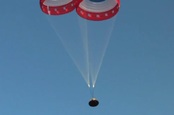This article is more than 1 year old
Two out of three parachutes... is just as planned for Boeing's Starliner this time around
Abort test simulated a very bad day – now, how about getting it to the ISS?
Boeing has put the CST-100 Starliner's parachutes through their paces with a simulation of an abort early in the launch.
While the calamity capsule has yet to make its first visit to the International Space Station (ISS), Boeing and NASA have pressed ahead with testing its systems, in this case checking that the parachutes would do their thing even in the somewhat dynamic conditions of a launch abort.
SpaceX memorably showed off the abort capabilities of its Crew Dragon capsule by sacrificing a Falcon 9.
While SpaceX's capsule requires a water landing, Boeing's can touch down on dry land. Both use parachutes, but Boeing's landing technology also features airbags.
The recent test, conducted above White Sands Space Harbor in New Mexico, was all about the parachutes and seeing how they performed in "significantly different flight conditions than those seen with normal landings".
With the test article dropped from a high-altitude balloon, the engineers added to the simulation of a very bad day by also preventing one of the three main parachutes from deploying altogether. The trio were supposed to appear 98 seconds into flight (following parachutes to whisk away the forward heat shield and a successful inflation of the drogues) but only two pilot chutes were fired, increasing the loading on the system.
All went well, and the Starliner boilerplate landed approximate 150 seconds later.
The first crewed flight of the Starliner won't be until 2021 at the earliest, and the second attempt to reach the ISS with an uncrewed capsule is tentatively planned for later this year. Things did not go so well for the calamity capsule last time, although the parachutes did their thing, and the CST-100 (aka "Calypso") landed safely after a truncated mission.

Oh chute. Two out of three ain't bad, right? asks Boeing after soft-ish crew module landing
READ MORENASA and Boeing plan to continue testing the parachutes over the summer ahead of that next launch. The system is also very similar to the design used by NASA for returning lunar missions.
"Our parachutes have passed every test," said Starliner test manager Dan Niedermaier. "We continue to push our system because we know what's at stake. This demanding test program ensures Starliner can bring our astronauts home safe."
A cynic might take issue with that "every test" comment. Last year, a test of the abort engines saw only two parachutes pop out rather than the expected three. That time Boeing called the whoopsie an "anomaly" rather than use the altogether more distressing word "failure".
Still, the parachutes seem to be working at the moment. Now, if only Boeing can crack that whole pesky "getting to the ISS in the first place", the company will be all smiles and we might have to think of a new nickname for its calamity capsule. ®
